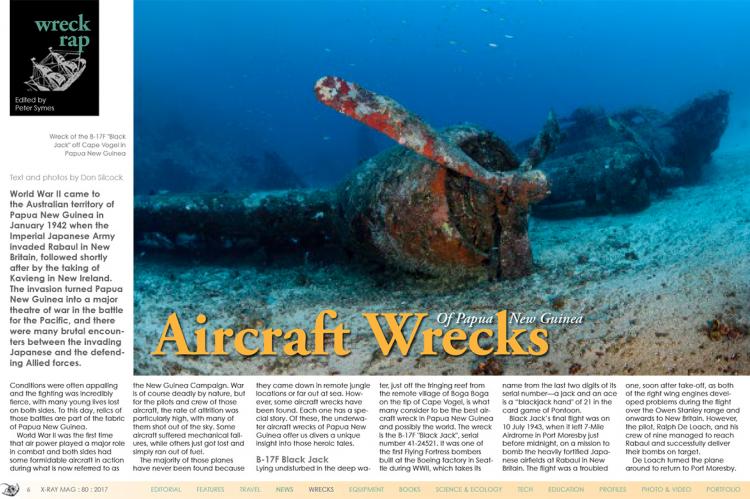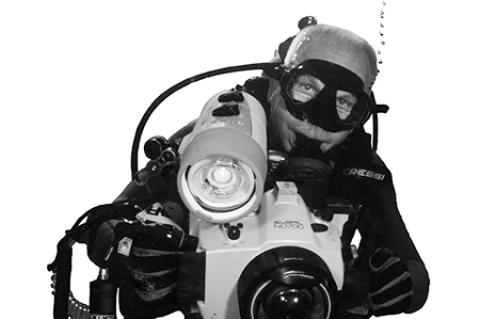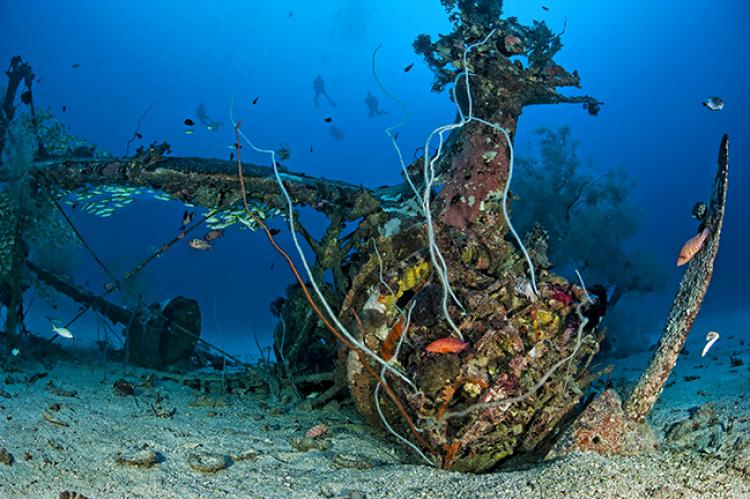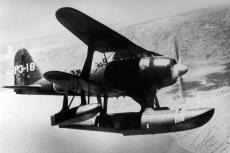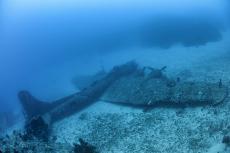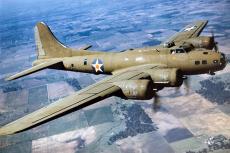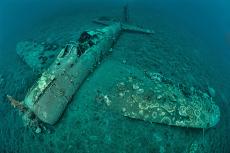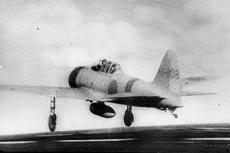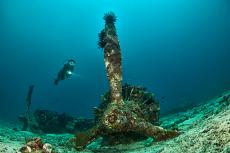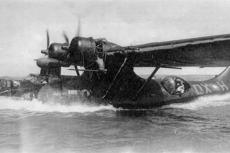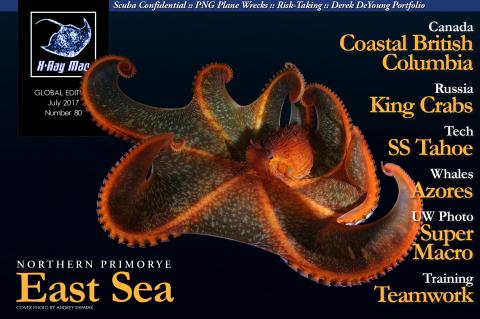Aircraft Wrecks of Papua New Guinea
World War II came to the Australian territory of Papua New Guinea in January 1942 when the Imperial Japanese Army invaded Rabaul in New Britain, followed shortly after by the taking of Kavieng in New Ireland. The invasion turned Papua New Guinea into a major theatre of war in the battle for the Pacific, and there were many brutal encounters between the invading Japanese and the defending Allied forces.
'Deep Pete' wreck of the Japanese Mitsubishi floatplane in Kavieng, New Ireland. Photo by Don Silcock.
Tags & Taxonomy
Conditions were often appalling and the fighting was incredibly fierce, with many young lives lost on both sides. To this day, relics of those battles are part of the fabric of Papua New Guinea.
World War II was the first time that air power played a major role in combat and both sides had some formidable aircraft in action during what is now referred to as the New Guinea Campaign. War is of course deadly by nature, but for the pilots and crew of those aircraft, the rate of attrition was particularly high, with many of them shot out of the sky. Some aircraft suffered mechanical failures, while others just got lost and simply ran out of fuel.
The majority of those planes have never been found because they came down in remote jungle locations or far out to sea. However, some aircraft wrecks have been found. Each one has a special story. Of these, the underwater aircraft wrecks of Papua New Guinea offer us divers a unique insight into those heroic tales.
B17F Black Jack
Lying undisturbed in the deep water, just off the fringing reef from the remote village of Boga Boga on the tip of Cape Vogel, is what many consider to be the best aircraft wreck in Papua New Guinea and possibly the world. The wreck is the B-17F "Black Jack", serial number 41-24521. It was one of the first Flying Fortress bombers built at the Boeing factory in Seattle during WWII, which takes its name from the last two digits of its serial number—a jack and an ace is a “blackjack hand" of 21 in the card game of Pontoon.
Black Jack’s final flight was on 10 July 1943, when it left 7-Mile Airdrome in Port Moresby just before midnight, on a mission to bomb the heavily fortified Japanese airfields at Rabaul in New Britain. The flight was a troubled one, soon after take-off, as both of the right wing engines developed problems during the flight over the Owen Stanley range and onwards to New Britain. However, the pilot, Ralph De Loach, and his crew of nine managed to reach Rabaul and successfully deliver their bombs on target.
De Loach turned the plane around to return to Port Moresby. But on the way back, it ran into a violent storm on approach to the coast of New Guinea to the northwest of Cape Nelson, a situation the pilot later described as “the blackest of black nights… the worst flying weather I’d ever seen in my life”.
Running low on fuel, and with two engines malfunctioning badly, De Loach decided against trying to get over the Owen Stanley Range to reach Port Moresby and turned Black Jack southeast towards Milne Bay, but was forced to ditch the plane at Boga Boga. The crew survived the crash landing and managed to scramble out of the plane before it sank down to the sandy seabed some 50m below, where it lay largely forgotten for another 43 years.
The discovery of Black Jack reads like something out of an adventure novel, with three Australians—Rod Pierce, Bruce Johnson and David Pennefather—stumbling on the wreck, almost by accident, in late December 1986, while searching for a completely different wreck. The villagers at Boga Boga had told Pennefather that a plane had crashed near their reef in WWII and he believed it might be the Australian Beaufort A9, which had crash-landed off Cape Vogel in November 1942. Pierce, Johnson and Pennefather organized an exploration trip on Rod Pierce’s liveaboard dive-boat, MV Barbarian, to search for the wreck.
Pearce found the wreck when he spotted the large tail-plane, as he made his way along the edge of the fringing reef at Boga Boga. As someone who had dedicated his life to wreck diving, it must have been like finding the Holy Grail. Over the next few days, they dived the wreck as much as its depth of nearly 50m would allow, entering the inside of the plane and finding the Radio Call Plate with the 24521 serial number on it, which later allowed them to positively identify it as the famous Black Jack.
Diving the Black Jack is a unique experience, as the plane is so intact. Sitting as it does on a sandy seabed in clear blue waters with visibility that can easily reach 40m, it is almost like a set from a Hollywood movie! The nose is badly crumpled from the impact of the crash landing and the propellers on the four engines are somewhat twisted, but the rest of the plane is all there. It is quite a remarkable sight after 73 years underwater.
Kimbe Bay’s Zero wreck
As the story is told around the bar at Walindi Resort, the day the Zero was found by local villager William Nui, was not long after a small plane had crashed on take-off from Hoskins Airport in Kimbe Bay. So, when William saw a plane laying on the sandy sea floor, he thought he had found the wreckage of the recent crash—not that of a WWII Japanese fighter plane, which had remained undisturbed for nearly 60 years.
William was freediving for sea cucumbers when he noticed what seemed to be a large shadow on the seabed. Like many people in Papua New Guinea, he was very superstitious and thought that he was looking at a ghost lying face-up, with its arms outstretched, soaking up the sun. Terrified, he shot to the surface and the relative safety of his canoe, eventually summoning up enough courage to go back down to take a closer look—realizing that it was the wreck of a plane rather than some demon of the deep.
William took his story to the local authorities and word of the discovery made it to Max Benjamin, the owner of Walindi Plantation Dive Resort, who although somewhat doubtful about its veracity, felt that it should be checked out. What Max found was a WWII Mitsubishi Zero in quite remarkable condition despite its six decades underwater.
There were no signs of bullet holes or combat damage to indicate that the plane had been shot down, rather the “off” position of the throttle lever and the pitch control set to reduce air speed clearly pointed to a controlled crash landing. In all probability, the pilot had got lost and ran out of fuel—a relatively common occurrence during the New Guinea campaign and confirmed by Japanese records showing that, in 1942, only 10 Zero pilots were shot down in air combat, but 16 had disappeared due to “unknown causes”.
The aircraft’s serial number and date were still visible on the wreck, and military records show that the plane went missing during the battle of Cape Gloucester on West New Britain on 26 December 1944. The pilot on that day was Tomiharu Honda, but his fate remains a mystery, although a local story suggests that some locals who saw the plane come down helped him ashore and took him to the nearby village of Talasea.
What happened after that remains a mystery, but one theory is that losing a plane due to navigational errors would have been a very significant loss of honor, and Honda, unable to deal with such a loss of face, spent the rest of his life in the jungles of New Britain. An alternative but slightly more gruesome notion (which is very popular around the bar at Walindi) is that he ended up as the main course of a ceremonial feast for a head-hunting tribe—a practice still common in those days.
New Ireland’s “Deep Pete”
While Rabaul was Japan’s main base along the southern rim of the Pacific, Kavieng in nearby New Ireland also played a significant role in the grand Japanese plan for control of New Guinea, together with the isolation and possible invasion of Australia to the south. Kavieng’s strategic location to the north of Rabaul meant that it could be used to protect both Rabaul and the Japanese supply convoys coming down to New Guinea from Japan and the huge Imperial Navy base at Truk Lagoon in the central Pacific.
At Kavieng, the Japanese significantly expanded the original Australian-built airfield and set up a sea-plane base, which, when the tide of war turned, became an important target for the Allied forces. There are more known aircraft wrecks around Kavieng than anywhere else in Papua New Guinea, and my personal favorite is the “Deep Pete” because I think it is the most photogenic.
The plane is a Mitsubishi F1M float-plane, which was designed and built to be launched by catapult from battleships, cruisers and aircraft tenders and used for reconnaissance missions. However, it also saw service as an impromptu fighter, dive bomber and patrol aircraft. The Mitsubishi F1M was a biplane, with a single large central float and stabilizing floats at each end of the lower wing. Early versions suffered from poor directional stability in flight, and were prone to “porpoise” when on the water, which may explain why the wreck is actually there.
The name “Pete” comes from the way the Allied Forces identified enemy aircraft during WWII, as the actual Japanese naming convention was difficult to understand and pronounce. Plus, there were two names for each aircraft—with one being the manufacturer’s alphanumeric project code and the other the official military designation.
So, the Allies used code-names instead: Men’s names were given to fighter aircraft; women’s names to bombers and transport planes; bird names to gliders; and tree names to trainer aircraft.
The wreck of the Pete float-plane is located on the western side of Nusa Lik (small Nusa) Island, which, along with Big Nusa Island, provides the shelter for Kavieng’s harbor. The wreck lies on its back, with the remains of its main float sticking up, on flat white sand in 40m of water—hence the name “Deep Pete”. As it is on the Pacific Ocean side of Kavieng, diving it on an incoming tide means that the visibility is often exceptional and usually in excess of 30m.
Although its tail is broken, its biplane shape is remarkably intact, given the relatively lightweight and fragile nature of the aircraft. What makes the Deep Pete so photogenic is the resident school of yellow sweetlips that stream in and around the wings, as well as the batfish and barracuda, which patrol in the clear blue waters above the wreck. At just 31ft long, with a wingspan of 36ft, Deep Pete is not a big wreck, but given its depth of 40m and the square profile of the dive, there is rarely enough time to fully explore it, and at least two dives are required to fully appreciate and photograph it.
New Ireland’s Catalina wreck
The wreck of the Royal Australian Air Force (RAAF) PBY Catalina A24-11 lays in 20m near the entrance to Kavieng’s harbor. The Catalina flying boat was developed by the US Navy in the 1930s as a long range patrol bomber. Although slow and somewhat ungainly, the Catalina flying boats served with distinction during WWII, both in the role for which they were designed, and as a very effective way of rescuing downed airmen. Their ability to land on water meant that they could be used to quickly and effectively rescue crews that had gone down in the Pacific. They are credited with saving the lives of thousands of Allied aircrews.
PBY A24-11 had taken off from Rabaul with six other RAAF Catalinas on a mission to attack the Japanese base at Truk Lagoon and had landed at Kavieng to take on fuel before heading north in to the Pacific. After refueling at Nusa Island, the Catalinas took off again one by one, but disaster struck when it was the turn of A24-11, as one of its wing bombs was hit by sea-swell causing it to explode. The force of the explosion killed the crew instantly and sent what was left of the Catalina to the bottom of the harbor entrance, where it lay until 2000, when Rod Pierce found the wreckage.
The engines are what makes the Catalina wreck special, as they stand proud on the seabed, surrounded by those parts of the plane that were not obliterated in the explosion. Whenever I dive the Catalina, my thoughts always return to the brave crew suspended in the flimsy fuselage below those massive engines. Like all the crews of the aircraft wrecks of Papua New Guinea, they were simply doing their duty to their country. Some lived to tell the tale, but many did not, and the aircraft wrecks of Papua New Guinea are poignant reminders of the sacrifices these servicemen made. ■
Based in Bali, Indonesia, Don Silcock is the Asia correspondent for X-Ray Mag. Check out his website Indopacificimages.com for the extensive location guides, articles and images on the diving in Papua New Guinea and other diving locations in the Indo-Pacific region.
Download the full article ⬇︎
